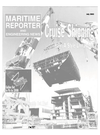
Molding the five-deck Trailership
Having emerged in recent years among Europe's top echelon of builders of RoRo vessels, Flensburger Schiffbau- Gesellschaft (FSG) has put down a newmarker for the industry by anticipating demand for a future generation of RoRo ferries incorporating a capacity for 6,000 lane-m of freight.
Closely following its formalization of an order from North Sea and Baltic RoRo specialist DFDS for a fifth newbuild capable of loading 4,000 lane-m of road trailers, rolltrailers, cassettes, and other cargo, the German shipyard has unveiled its proposal for a 6,000 lane-m carrier.
The Flensburger offering, which has already attracted the interest of operators looking to achieve further scale economies on high-volume routes, combines an unprecedented arrangement of five trailer decks and flexible freight distribution with a rapid service speed of 23-knots. The design thereby promises high productivity as well as a major advance in unit capacity.
The German yard's international competitiveness springs from a continuing plough-back of funds into research and development and a preoccupation with efficiency as concerns both its homegrown designs and its in-house processes.
In setting out to formulate a state-ofthe- art RoRo incorporating more cargo space than any other design available on the market, FSGs technical team sought to ensure compact overall dimensions so as to keep initial investment costs as low as possible.
At 722 ft. (220 m) length overall, the 6,000 lane-m design is only 88 ft. (27 m) longer than the three-deck UND Akdeniz of 2,640 lane-m. and 'three-and-ahalf deck variants of 3.256 lane-m built at Flensburg for Turkish operator UND RoRo Isletmeleri. FSG's propensity for design development within a compact hull envelope was also expressed by the main dimensions of approximately 656 x 87 ft. (200 x 26.5 m) used for the milestone 4,000 lane-m class destined to make its debut in the DFDS Tor Line network during September next year.
In each case, though, the proposed new trailership behemoth is substantially more beamy, at 98 ft. (30.4-m) breadth. Good seakeeping behavior to ensure schedules and cargo safety on the most rigorous of shortsea freight routes has been a tenet of the design project, as has a turnaround capability that belies the huge cargo intake, to safeguard schedules.
Close attention to hull form, hydrodynamic performance and propulsive plant configuration has resulted in an attractive speed and power relationship, bearing on freight ton-mile efficiency and also capital outlay. The favored layout keeps faith with the diesel-mechanical concept, comprising four medium-speed engines driving twin controllable pitch propellers through reduction gearing.
The engine written into the provisional specification is a seven-cylinder version of the MaK M43 series from Caterpillar Motoren, for a total plant output of 25,200-kW.
Just as the 4,000 lane-m size has come to be favored by a number of Nordic operators besides DFDS, the 6,052 lanem design from Flensburg could be the next trendsetter. The as yet unique provision of five decks suited to trailerborne freight comprises four enclosed decks plus the weather deck, served by an inter-deck ramp system configured to allow simultaneous working of four different cargo areas. RoRo access is concentrated over twin stern ramps.
In the meantime. FSG is set to deliver the Hurst Point, the first of four 23,300-gt RoRo sisters contracted by British consortium AWSR for strategic sealift duties under a transport service agreement with the U.K. Ministry of Defense. The 2,600 lane-m heavilyreinforced design incorporates three decks, with the addition of a 36-ton crane on the weatherdeck, and further demonstrates the German yard's propensity for meeting bespoke RoRo requirements within the bounds of efficient production practices.
Read Molding the five-deck Trailership in Pdf, Flash or Html5 edition of July 2002 Maritime Reporter
Other stories from July 2002 issue
Content
- Zodiac Debuts Bulletproof System For CRRC page: 5
- Historic $17 Billion Order Placed page: 6
- USCG Proposes New Changes in Vessel Arrival/Departure Procedures page: 9
- NASSCO Celebrates Keel Laying of Trailerships page: 11
- Industry-Wide Interoperability Investment Paying Off page: 12
- Tribon M2 Aim: Better Ships at a Lower Cost page: 14
- Total CAD/CAM Solution for Ship Design and Building page: 15
- Juniper Industries Keeps the Water Out page: 17
- Molding the five-deck Trailership page: 18
- IZAR Gijon Delivers Dredger page: 19
- Estonians Raise the Ferry Stakes page: 19
- Transportation Secretary Announces $92.3M in Port Security Grants page: 21
- USS Shoup Commissioned page: 23
- U.K. Royal Navy Increases Overhaul Efficiency of HP Air Cylinders page: 24
- DD(X) Dispute: BIW Files Protest page: 25
- Technological Wonder, No Matter How You SLICE It page: 26
- GALILEO: 2008 or Bust? page: 28
- Forget the Dog, MTN Delivers the News Onboard Residensea page: 29
- SeaWave Aims to Drive Down Communication Costs page: 29
- Iridium Aggressively Pursues New Outlets page: 30
- Fincantieri Stays Strong page: 32
- Fincantieri Predicts Clear Vista For HAL page: 32
- Rodriquez Cantieri Navali: Fast Company page: 33
- SEA RIDER Infiltrates Small Craft Propulsion Market page: 34
- ACG Makes Solid Inroads page: 35
- SubSea Solutions Alliance Provides Quick Fix - Underwater page: 36
- Classic Vessel's Demise Lead to New Found Hobby page: 38
- STAR Center Provides 360-Degree Field of View page: 41
- MAN B&W 48/60B Engine page: 42
- Titan Pulls One Off for Marine Response Alliance page: 54


